Snapshot of the Canadian Beef Industry
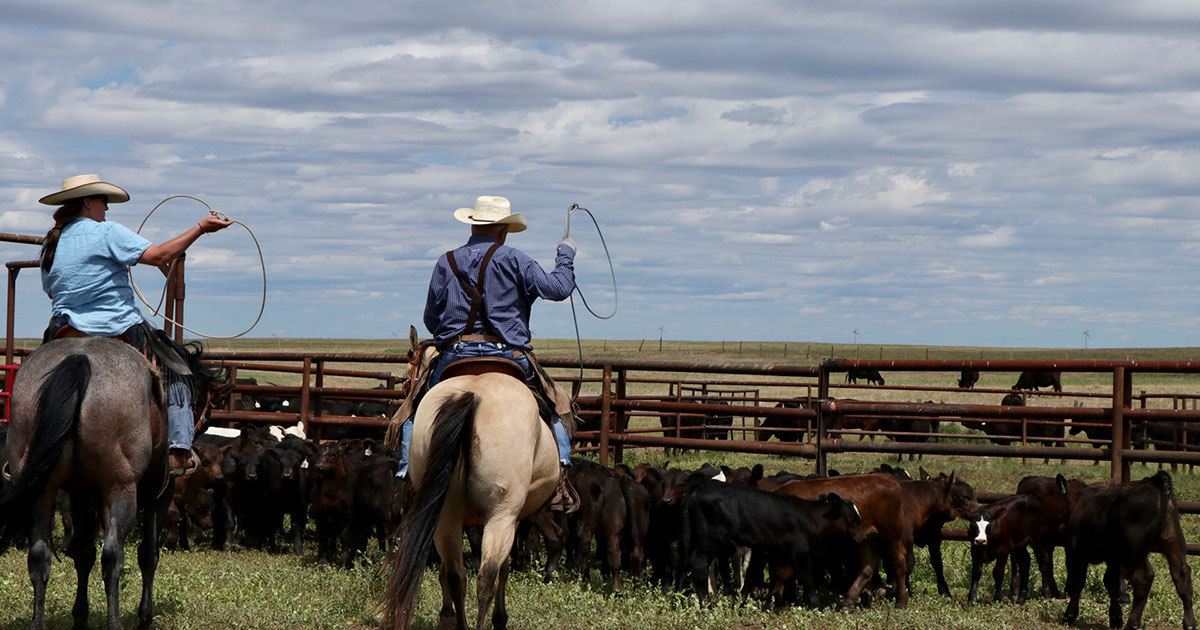

Recently I spent ten months in Alberta, Canada, to learn about the Canadian beef industry. Prior to travelling I had imagined our industries to be relatively similar (despite the obvious contrasts in winter weather) but I soon learnt there are quite a few operational differences. This article will focus on the Southern Alberta production system as this where I spent the majority of my time.
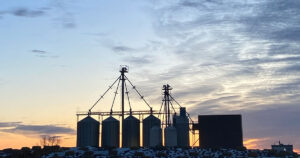 The drastic fluctuation in weather through the seasons compels most producers into grain finishing their cattle, flooding the feedlot industry with freshly weaned calves in the fall (autumn) months. This results in a highly consistent beef product being produced across the Canadian supply chain. Consequently, beef marketing is simplified, sold primarily based on the quality grade ascribed. However, the Canadian beef industry is quickly changing pace with a large influx of beef on dairy beef calves entering the Western Canadian feedlots and processing plants.
The drastic fluctuation in weather through the seasons compels most producers into grain finishing their cattle, flooding the feedlot industry with freshly weaned calves in the fall (autumn) months. This results in a highly consistent beef product being produced across the Canadian supply chain. Consequently, beef marketing is simplified, sold primarily based on the quality grade ascribed. However, the Canadian beef industry is quickly changing pace with a large influx of beef on dairy beef calves entering the Western Canadian feedlots and processing plants.
The Canadian beef industry is comprised of 10.3 million beef cattle (Statistics Canada, 2023), produced predominately in the Central Western states (Alberta [44%], Saskatchewan [29%] and Manitoba [11%]) (Canadian Beef, 2023). Cow calf herds are primarily operated on smaller family owned mixed-farming operations and the majority of owners have some form of additional off farm income. As a result, the average cowherd size per ranch is 69 head across the whole of Canada; rising only slightly to 88 cows per ranch in Alberta (Canadian Beef, 2023). Most herds are comprised of British or Continental crossbreds; of the commercial producers I was exposed to very few maintained purebred blood lines within their herds.
Southern Alberta ranches typically receive between 300 and 350 mm of annual precipitation (rain and snow combined) and are composed of native mixed prairie grass swards. The Foothills, at the base of the Rocky Mountain range, on average receive upwards of 500 mm annual precipitation and more commonly contain Foothills Fescue (Bailey et al., 2010). Fortunately for the area most of the precipitation occurs during summer, the critical growing season (May to July). The harsh winters, with daytime temperatures between -5°C to -15° and occasionally dropping as low as -35°, completely halt pasture production. Over this period, most ranchers are required to feed their cowherd, commonly with stored silage or hay from the previous summer.
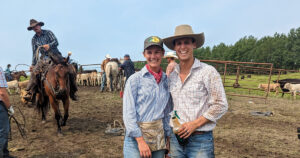 Subsequently, calves in Western Canada are generally born in late winter to spring (late February to May). Enabling ranchers to line up the peak pasture growing season with the cow herds nutritional requirements during lactation. Between May and July, when calves are around 2 to 4 months of age, it is branding season, a community affair and one of my favourite memories from Canada. It is a time when all come together supporting neighbouring ranches as they vaccinate, castrate and tag.
Subsequently, calves in Western Canada are generally born in late winter to spring (late February to May). Enabling ranchers to line up the peak pasture growing season with the cow herds nutritional requirements during lactation. Between May and July, when calves are around 2 to 4 months of age, it is branding season, a community affair and one of my favourite memories from Canada. It is a time when all come together supporting neighbouring ranches as they vaccinate, castrate and tag.
There are few ranchers that still hot brand their calves. We were fortunate to experience several different methods of catching calves from traditional roping, calf wrestling to the use of nord forks to restrain calves and flat ass branding (no horses or ropes). The hard work is always rewarded by a feast and a party; this experience of the Western cultural traditions of roping and community comradery was truly special to part take in.
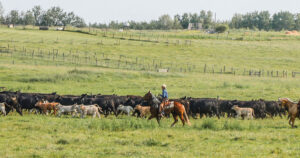 Following branding, calves are generally weaned in fall and placed into feedlots over the winter months (reducing stored feed requirements on ranches). Few ranchers will keep weaned calves over the winter months, due to the additional cost in feed. However, it may be common where storing of feed is cost effective.
Following branding, calves are generally weaned in fall and placed into feedlots over the winter months (reducing stored feed requirements on ranches). Few ranchers will keep weaned calves over the winter months, due to the additional cost in feed. However, it may be common where storing of feed is cost effective.
For example, bull calves may be kept for the following spring’s bull sale or calves may be kept to a yearling stage and sold to feedlots when the market prices are generally higher in spring.
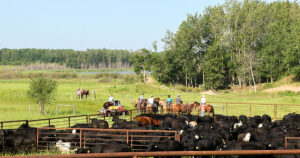
The fall run is characterised by a high influx of unweaned calves, straight off their dam onto trucks, and into feedlots. Calves are marketed eithervia auction marts (saleyards), direct sales or internet sale systems. Generally, feedlot entry weights during the fall run for calves vary between 450 and 600 lbs (200 and 275 kgs). The vast majority (>90%) of beef cattle are finished on grain and are most commonly fed for 180 to 280 days or until the target live weight is reached of 1250 to 1550 lbs (550 to 700 kgs). Heifers will commonly be slightly lighter and when cost effective feedlots may increase the target live weight, depending on the heavy discounts being imposed by processing plants at the time. If kept till yearling stage prior to feedlot entry in spring, animals are usually only fed around 150 days aiming for a similar finishing weight as fall-entry calves.
Furthermore, a sizeable proportion of all beef produced nationally (approximately 85%) is processed across 3 plants operated by either Cargill or JBS (Edmiston, 2020). The 2 plants situated in Southern Alberta each process up wards of 4000 animals per day. The beef produced via these management practises is highly consistent because of the reliability and quality of nutrition supplied through feed lotting. Hence, there is limited need for branded beef programs to differentiate beef in the marketplace. Other than CAB (Certified Angus Beef), most branded beef programs are more inclined towards natural or NHTC (Non hormone treated cattle) programs. Rather, beef is primarily sold based upon the attributed quality grades (e.g. Prime, AAA, AA or A). Canadian beef processing plants will likely continue to grow as the industry is able to capitalise on the year-round availability of beef on dairy animals entering Canadian feedlots.
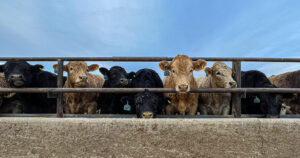 EVOLVING INDUSTRY – BEEF ON DAIRY
EVOLVING INDUSTRY – BEEF ON DAIRYOver the past five to ten years, the introduction of beef on dairy calves has been changing the traditional seasonality experienced in the Canadian beef industry. The beef on dairy calves, majority of which are imported from the United States year-round have been well adopted by the feed lotting sector in Western Canada, as they provide the opportunity for feedlots to be at capacity at all times.
Beef on dairy animals are typically raised by calf ranches for their first 150 days, from 85 to 350 lbs (40 to 150 kgs). Calves are fed milk replacer until weaning around 45-65 days of age. This is either fed via bottles, buckets or group feeders. After weaning until about 100 days of age, calves are fed a hutch ration gaining approximately 0.5 kgs per day. Generally, calves are housed in single hutches for this period of time to reduce the health burden placed upon the calves. For their final 50 days at the calf ranch calves are housed in mixed pens and fed a grower ration (about 15-20% roughage), gaining approximately 1 kg per day.
The majority of the beef on dairy calves I was exposed to in Southern Alberta were trucked from calf ranches in Southern USA. Once in the feedlot calves are treated as ultra-high-risk animals and therefore are vaccinated and cared for accordingly. Due to the nature of dairy animals to grow taller as opposed to putting on weight, beef on dairy animals are commonly restricted fed for a proportion of their life, unlike their beef cattle counterparts who are typically aimed at being fed ad lib. The industry is still learning about the management of these animals from the selection of beef genetics to best practise for raising the calves in the calf ranches and in feedlots. Nonetheless, there has been significant improvement in the production of beef on dairy animals and an increase in collaboration between the dairy and beef industries.
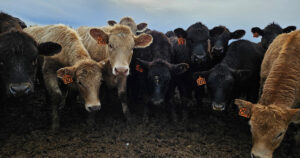 SUMMARY
SUMMARYThe vast majority of Canadian beef calves enter feedlots during the fall months, as pasture production ceases throughout winter. This production system produces a very consistent end product, allowing a simplified beef marketing approach with limited product differentiation. However, Canada’s beef industry is changing with the increase in beef on dairy animals present in the supply chain, allowing a more consistent flow of animals into feedlots throughout the year. As Australia and New Zealand look to implement beef on dairy supply chains, we can learn from the established pathways present in Canada and the US.
– Hanlie Jansen, Extension Officer